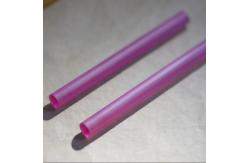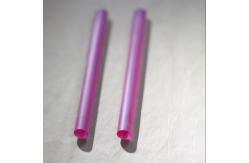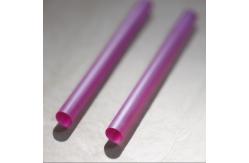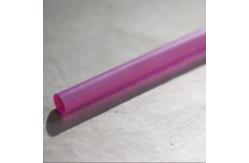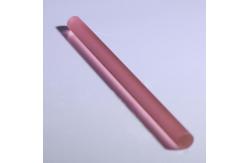Synthetic Ruby Rods Cr:Al₂O₃ Available in 2mm/4mm Dia10mm/20mm Lengths
|
Synthetic Ruby Rods (Cr:Al₂O₃) Available in 2mm/4mm Dia10mm/20mm Lengths
Abstract of the Ruby Laser Rod?The ruby laser rod is a cylindrical crystal made from synthetic ruby, a material composed primarily of aluminum oxide (Al₂O₃) doped with approximately 0.05% to 0.5% chromium ions (Cr³⁺). These chromium ions are responsible for the laser activity in the ruby. The ruby rod is typically pink or red in appearance, with the intensity of its color depending on the concentration of chromium ions. The ruby laser is classified as a solid-state laser, meaning its lasing medium is a solid material, as opposed to gases, liquids, or semiconductors. The ruby used in the laser rod is artificially manufactured to ensure purity and uniformity, making it an ideal medium for producing laser light.
The Attribute Table of the Ruby Laser Rod
The working principle of ruby laser rods1. Energy Absorption (Pumping)The ruby laser rod is optically "pumped" using a high-energy light source, such as a xenon flash lamp or a krypton lamp. The energy from the lamp excites the chromium ions within the ruby crystal, raising their electrons to higher energy states. 2. Spontaneous EmissionAfter absorbing energy, the excited electrons in the chromium ions cannot remain in their higher energy states indefinitely. They spontaneously drop to a slightly lower energy state, releasing photons in the process. This is called spontaneous emission. 3. Stimulated EmissionSome of the emitted photons stimulate other excited electrons to release their energy in the form of additional photons. These photons are coherent, meaning they have the same wavelength, phase, and direction. This process of stimulated emission amplifies the light within the ruby rod. 4. Light Amplification and ResonanceThe ruby laser rod is placed between two mirrors—one fully reflective and the other partially reflective. These mirrors form a resonant optical cavity, bouncing photons back and forth through the ruby rod. This repeated passage of light amplifies the coherent light through further stimulated emissions. 5. Laser OutputA portion of the amplified light escapes through the partially reflective mirror, producing a narrow, intense beam of red laser light with a wavelength of 694.3 nm. Structure of a Ruby Laser1.Laser Ruby Rod
2.Pump Source
3.Optical Cavity
4.Cooling System Advantages of Ruby Laser Rods1.Simplicity: The straightforward design of the ruby laser makes it easy to construct and operate.
2.High Coherence: The emitted laser beam exhibits excellent coherence, making it suitable for precision applications.
3.Durability: The solid-state nature of the ruby rod ensures a long operational lifespan under normal conditions. Applications of Ruby Laser Rods1.Holography: The coherent light from ruby lasers is ideal for creating high-quality holograms.
2.Medical Procedures: Ruby lasers have been used for tattoo removal, skin treatments, and other dermatological procedures.
3.Rangefinding: Early laser rangefinders relied on ruby lasers for precise distance measurements.
4.Scientific Research: Ruby lasers have been employed in experiments requiring coherent and monochromatic light sources.
5.Education: As a simple and accessible laser system, ruby lasers are often used in educational demonstrations. Q&AQ:How should ruby laser rods be stored and handled to maintain performance?
A:Storage: In a dry, dark environment (Cr³⁺ is photosensitive). Cleaning: Use methanol (avoid abrasive cleaners). Avoid: Direct UV exposure, fingerprints on polished faces, or thermal cycling beyond 200°C.
Other related products Cr Al₂O₃ Ruby Rod Sapphire Laser Single Crystal Optical Rod Customized |
|||||||||||||||||||||||||||||||||||||||||||||||||||||||||||||||
| Product Tags: 4mm Synthetic Ruby Rods 2mm Synthetic Ruby Rods Synthetic Ruby Rods |
|
|
TGV Glass Substrate Through-hole Coating Semiconductor Packaging JGS1 JGS2 |
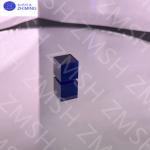
|
Royal Blue Sapphire Raw Gemstone Synthetic Colored For Durable Exquisite Jewelry & Watch Case |
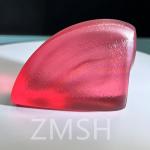
|
Paparacha sapphire raw gemstone lab-made orange pink sapphire gemstone Mohs hardness 9 |
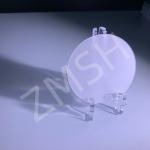
|
Sapphire Wafer Monocrystal Al2O3 DSP SSP 2inch 4inch 6inch 8inch 12inch A plane C plane |
|
|
Sapphire wafer 2inch C-plane(0001) DSP SSP 99,999% Monocrystalline Al2O3 LEDS Semiconductor |
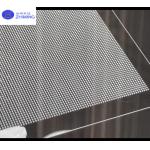
|
Through Glass Vias (TGV) For JGS1 JGS2 Sapphire Corning Glass For Sensors Manufacturing And Packaging |

